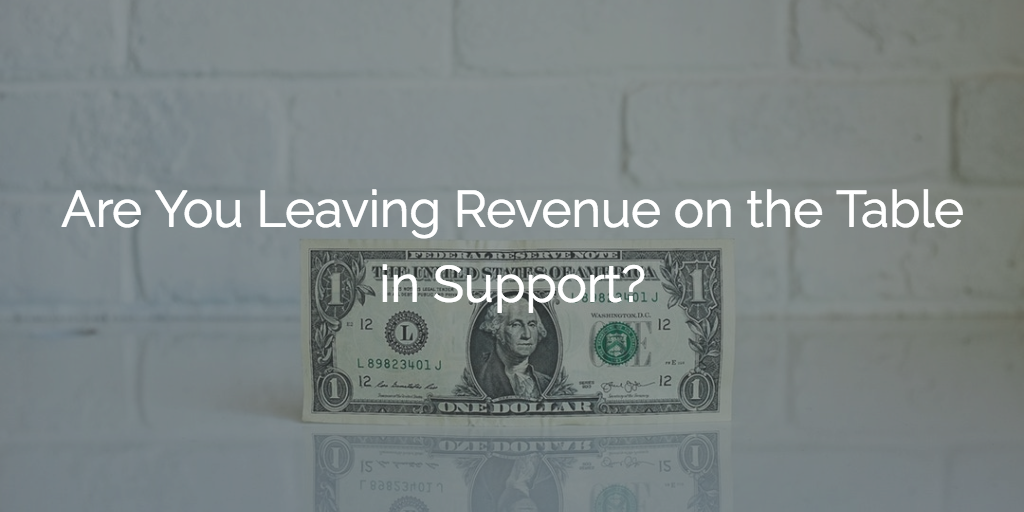Supporting your product is a cost center. It’s just one of the necessary facts of doing business—you have to pay to play, right? But what if your Support team could be a revenue engine instead?
During our most recent Pulse event, I had the pleasure of speaking in detail about the “Support Experience” and how to bring your Support department into the Customer Success conversation. As part of that presentation, I did quite a bit of research into the industry. Some of the findings led us to expand the work we’ve done so far in our maturation of the department. We started looking at where we could set up more customers for success and find additional revenue by selling them a support package.
Industry Insights
For starters, let’s take a moment to chat about some of the reasons why your company should be offering a level of “Premium Support.” First, according to a study done by RightNow, 82% of customers will leave a company based on a bad customer service experience. Additionally, the survey showed that an astounding 85% of customers would pay up to 25% more money for a better customer experience.
Companies in the B2C space are starting to catch on to this reality—or at least their marketing teams are! These are some of my favorite commercials.
It sounds like the most basic consumer right of customer experience, doesn’t it? Maybe in the massive effort to automate every single aspect of customer service, their competitors forgot just how important the human-first concept was.
And the data supports the value of human interaction, specifically. A study from Genesys showed that 40% of those surveyed about their most-desired service improvements wanted better human interactions. While things like ticket deflection and automation are (and should be) important to your Support team, providing better human service should be a priority as well. If your competitors are doing it better, it could cost you.
Gainsight Insights
There are many reasons why a customer might purchase a support package. In this blog post, I covered why you need Premier Support as both a component of your own Support Team and as part of your Gainsight experience. Gainsight offers three support levels. Standard Support comes with the purchase of Gainsight but you can upgrade to Premier or Elite Support. There are a variety of things that come with our packages including expedited SLAs, extended Support hours, a dedicated point of contact, and proactive support. It is one of our best selling add-on packages, and in just over two years, we have grown the department from three BETA customers to over 150 paying customers.
Even though this package is very popular and Sales is pitching it during the early stages of the sales cycle, what about the customers who already own the product? How can you identify them, and more importantly, how can you position the upsell into these packages?
If you have read through my blog post on Premier Support, you understand the foundation of our department is data. We calculate and compare customers to both themselves and other customers with the same characteristics. When we see habits start to trend in a risky direction, we intervene and take action. What if I told you that you could use the same data to identify the customers who would be a good fit for an additional package?
Which Customers Are Good Fits for Premier Support?
1. High-Volume Customers
Customers who submit a large number of support tickets tend to be good candidates for a support package. Keep in mind, we are not trying to pitch to the customer that owning a Premier package in itself will drastically reduce support tickets. There are several things included in Premier packages that will help. Expedited SLAs, Priority Case Routing, and Case Review meetings are just a few upgrades that provide value to these customers.
2. Customers With Multiple Risks
Customers who experience multiple risks and escalations also make good candidates for an upgraded support package. Just to be clear, I’m not saying that you should take at-risk customers and throw paid packages at them as a solution. You need to align customers with the specific value propositions in the package that can alleviate their pain points. For example, a dedicated Point of Contact, Proactive Case Monitoring, and Operations Reviews can provide value to customers prone to escalation.
3. High ARR Customers With Upcoming Renewals
Depending on your specific model, customers with high ARR or large expansion possibilities should always be on your radar for a support package. Internally, all our enterprise customers own one, and it requires a support review and approval for one of these customers to not purchase one of these plans. With these customers being your most important and strategic accounts, we do everything possible to set them up for long-term success.
Gainsight and Support Expansion Opportunities
Now that you’ve identified customers that could benefit from an upgraded support package, you need a process to execute. Here is how we leverage the data and processes outlined above.
Bionic Rules: We’ve set up a couple Bionic Rules that look at ticket volume, the number of support risks, and customers above a threshold for ARR/expansion. We use these rules to fire off Calls To Action (CTAs) which are assigned directly to the Premier Support Manager.
Calls To Action: We’ve set up these CTAs with specific playbooks that guide the assignee in a standardized process to engage the client about support packages. This playbook directs the assignee to:
- Check for any open risks
- Analyze support habits
- Align those habits with Premier/Elite value
- Create a deck with features/value props
- Embed support habit reports into the deck for a personalized story
- Meet internally to align on positioning
- Meet with the customer to pitch
- Perform a complementary Operations Review for client
Reports/Dashboards: We created dashboards that have global filters which allow us to pull very specific reports about our customers’ support habits—most important being how they compare both to themselves and to other customers with similar characteristics. This allows us to quickly analyze a customer’s support habits to determine if they really are a good candidate for a support package.
Support Collateral: We then take these reports and embed them directly into the support collateral deck which allows us to tell the story of how this package can really set them up for success.
Client Meeting: This takes a standard “here, buy this because of all these cool features” conversation and allows you to be prescriptive about why you singled them out as a candidate for this package. Customers appreciate the research that you do into their habits and I have had customers buy based on the information we share during this meeting. When you show them all the data and how it’s used, it’s a much easier sell.
Complementary Operations Review: One of the most popular features of our support packages is our Support Operations Review. In this review, we align customers’ habits with internal resources which should help them. For example, we can tell what Gainsight feature your tickets are in regards to, and if we see tickets coming in for just a few specific features, we can send over product documentation and training resources for the admins in this area. Shortly after the meeting, we conduct one of these for the client in hopes of securing the purchase of the package.
“Pass Back the Ball to Get the Upsell Won”
If you’ve seen Nick Mehta’s “Who’s Fired Up” rap video, you know to “pass me the ball when the deal is done.” Well, after we’ve followed the steps above, we pass the ball back to Sales/CSM in order to close the deal. Support does not (and should not) actually sell, however, it is our responsibility to provide Sales with the tools needed to sell these packages. At the end of the day, it all comes down to being human-first and doing our due diligence to set our customers up for success. When your approach to selling truly is need-based, it certainly makes the game a lot more fun to play.
I’m always up for a conversation about Support—whether it’s your support with Gainsight or your own’ company’s support offerings. Please reach out to me via email or LinkedIn and I would be happy to chat and share ideas.

